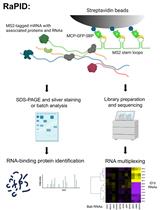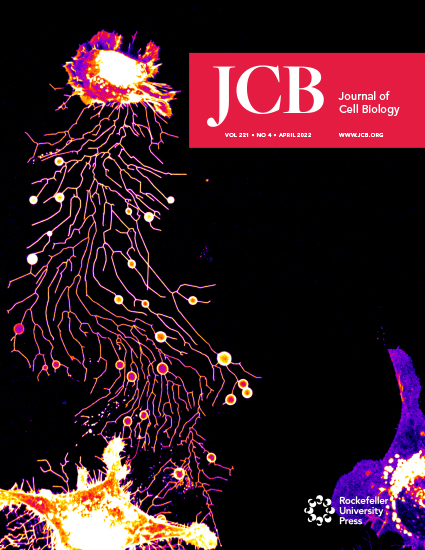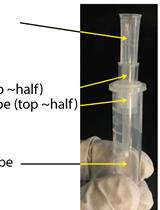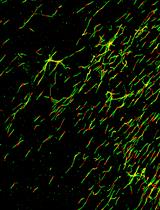- EN - English
- CN - 中文
Chromatin-RNA in situ Reverse Transcription Sequencing (CRIST-seq) Approach to Profile the Non-coding RNA Interaction Network
染色质-RNA原位逆转录测序(CRIST-seq)方法分析非编码RNA相互作用网络
发布: 2023年07月20日第13卷第14期 DOI: 10.21769/BioProtoc.4718 浏览次数: 1903
评审: Gal HaimovichRohini NairMarion Hogg

相关实验方案

基于适体的 mRNA 亲和纯化程序 (RaPID) 用于鉴定酵母中的相关 RNA (RaPID-seq) 和蛋白质 (RaPID-MS)
Rohini R. Nair [...] Jeffrey E. Gerst
2022年01月05日 4776 阅读
Abstract
Non-coding RNAs (ncRNAs) are defined as RNAs that do not encode proteins, but many ncRNAs do have the ability to regulate gene expression. These ncRNAs play a critical role in the epigenetic regulation of various physiological and pathological processes through diverse biochemical mechanisms. However, the existing screening methods to identify regulatory ncRNAs only focus on whole-cell expression levels and do not capture every ncRNA that targets certain genes. We describe a new method, chromatin-RNA in situ reverse transcription sequencing (CRIST-seq), that can identify all the ncRNAs that are associated with the regulation of any given gene. In this article, we targeted the ncRNAs that are associated with pluripotent gene Sox2, allowing us to catalog the ncRNA regulation network of pluripotency maintenance. This methodology is universally applicable for the study of epigenetic regulation of any genes by making simple changes on the CRISPR-dCas9 gRNAs.
Key features
• This method provides a new technique for screening ncRNAs and establishing chromatin interaction networks.
• The target gene for this method can be any gene of interest and any site in the entire genome.
• This method can be further extended to detect RNAs, DNAs, and proteins that interact with target genes.
Graphical overview

Background
Non-coding RNAs (ncRNA), which include long non-coding RNA (lncRNA), small nuclear RNA, small nucleolar RNA, micro RNA, and other unknown RNA, play a critical role in the regulation of gene expression through multiple molecular mechanisms (Huang et al., 2016; Sridhar et al., 2017). RNA chips were initially used to identify RNAs; later, single-cell RNA sequencing expanded the ability to catalog the RNAs transcribed in a cell (Sajti et al., 2020). However, the existing RNA screening methods only focus on whole-cell RNA expression (Liang et al., 2019, Nicot, 2020) and are not sensitive enough to capture every known (or heretofore unknown) ncRNA that targets an individual gene.
To profile the ncRNA regulatory network at a specific gene locus, we developed a chromatin RNA in situ reverse transcription-associated sequencing (CRIST-seq) assay (S. Zhang et al., 2019). CRIST-seq combines the simplicity of intranuclear in situ reverse transcription–associated biotin labeling of ncRNA molecules with the specificity of catalytically inactive CRISPR dCas9 gene targeting. The assay includes 1) targeting a given gene using lentiviral dCas9-gRNAs, 2) nuclear in situ labeling of ncRNAs by reverse transcription with biotin-dCTP, 3) pulldown of chromatin-associated cDNAs by Cas9-Flag immunoprecipitation, 4) isolation of the target gene–associated cDNAs with streptavidin beads, and 5) Illumina cDNA library sequencing. We have used this approach to identify several novel ncRNAs that regulate the pluripotency of stem cells through various molecular mechanisms, including Platr10 (Du et al., 2021), Oplr16 (Oct4 promoter-interacting long noncoding RNA) (Jia et al., 2020), Peblr20 (Pou5F1 enhancer binding lncRNA 20) (C. Wang et al., 2020), Osblr8 (Oct4-Sox2 binding long noncoding RNA 8) (Zhu et al., 2020), Osilr9 (Oct4-Sox2 interacting lncRNA 9) (Zhu et al., 2023), and Peln1 (pluripotency exit lncRNA 1) (Y. Wang et al., 2022).
In this paper, we have used the Sox2 gene, a critical stem cell factor required for pluripotent reprogramming, as an example to study and verify the feasibility of this method. This CRIST-seq approach may be broadly used to map ncRNA interaction networks at target loci anywhere in the genome by creating gene-specific gRNAs. CRIST-seq can be used to identify new ncRNAs and to study how these regulate gene expression in normal, stem, and cancer cells.
Materials and reagents
Consumables and reagents
6-well cell culture plates (Corning, catalog number: 3516)
100 mm cell culture dishes (BD Falcon, catalog number: 353003)
100 mm Petri dishes (BD Falcon, catalog number: 351005)
1.5 mL microcentrifuge tubes (Pierce, catalog number: 69715)
0.2 mL 8-tube stripes (Bio-Rad, catalog number: TBC0803)
15 mL centrifuge tubes (Labselect, catalog number: CT-012-15)
DH5α competent E. coli (NEB, catalog number: ST10018)
Chloroform (Fisher Chemical, catalog number: C298-500)
Isopropanol (Thermo Scientific, catalog number: AC610080040)
Ethanol (Thermo Scientific, catalog number: 10617864)
Phenol/Chloroform/Isoamyl Alcohol (25:24:1) (Fisher Bioreagents, catalog number: BP1752I-100)
Glycogen (5 mg/mL) (Invitrogen, catalog number: AM9501)
RNase inhibitor (Invitrogen, catalog number: AM2694)
Random hexamers (Invitrogen, catalog number: N8080127)
dNTP mix (2.5 mM) (Invitrogen, catalog number: R72501)
Hybrid-Q Plasmid Rapidprep (GeneAll, catalog number: 100-102)
FastDigest Restriction endonucleases Age I (BshT I), Not I, and DpnI (Thermo Scientific, catalog numbers: FD1464, FD0596, and FD1703)
10× FastDigest buffer (Thermo Scientific, catalog number: B64)
T4 DNA ligase (5 U/μL) (Thermo Scientific, catalog number: EL0011)
PEG-it virus precipitation solution (System Biosciences, catalog number: LV825A-1)
PEI (Polysciences, catalog number: 24765-1)
Polybrene (Sigma, catalog number: TR-1003)
Formaldehyde, 37% by weight (Fisher Chemical, catalog number: F79-500)
2 M glycine (Sigma, catalog number: G8898)
NP-40 (Thermo Scientific, catalog number: 85124)
HEPES (Sigma, catalog number: H3375)
0.5 M EDTA (Thermo Scientific, catalog number: R1021)
10% SDS (Sigma, catalog number: L3771)
Halt protease inhibitor cocktail (100×) (Thermo Scientific, catalog number: 87785)
PMSF protease inhibitor (Thermo Scientific, catalog number: 36978)
Triton X-100 (Thermo Scientific, catalog number: A16046AE)
Tween 20 (Thermo Scientific, catalog number: J20605AP)
Proteinase K (Invitrogen, catalog number: 25530049)
Dynabeads M-280 streptavidin (Invitrogen, catalog number: 60210)
Formamide (Sigma, catalog number: F9037)
Biotin-14-dCTP (Invitrogen, catalog number: 19518018)
Anti-Flag antibody (Sigma, catalog number: F1804)
Anti-IgG antibody (Abcam, catalog number: ab171870)
PureProteome Protein A/G mix magnetic beads (Millipore, catalog number: LSKMAGAG10)
RNase A (20 mg/mL) (Invitrogen, catalog number: 12091021)
AMPure XP beads (Beckman Coulter, catalog number: A63881)
NEBNext ChIP-Seq Library Prep Master Mix Set for Illumina (NEB, catalog number: E6240)
NEBNext Multiplex Oligos for Illumina Index Primers Set 1 & Set 2 (NEB, catalog number: E7335 and E7500)
Maxima reverse transcriptase (200 U/μL) (Thermo Scientific, catalog number: EP0743)
NEBNext mRNA Second Strand Synthesis Module (NEB, catalog number: E6111)
1 M TRIS-HCl pH 8.1 (Biyuntian, catalog number: ST781)
1 M TRIS-HCl pH 7.5 (Biyuntian, catalog number: ST775)
1 M TRIS-HCl pH 8.5 (Biyuntian, catalog number: ST785)
KCl (Thermo Scientific, catalog number: AC418200025)
NaCl (Fisher Scientific, catalog number: 15915)
MgCl2 (Thermo Scientific, catalog number: FERR0971)
Plasmids
pMD2.G (Addgene plasmid, catalog number: 12259)
psPAX2 (Addgene plasmid, catalog number: 12260)
P-GreenPuro (SBI plasmid, catalog number: SI505A-1)
Lenti dCas9-mSox2-gRNA #1-2-puro (constructed in our lab, see Procedure)
Cell culture and cell culture reagents
HEK293T cells (ATCC, catalog number: CRL-3219), stored in liquid nitrogen
Mouse FIB cells (muscle-derived fibroblasts), cultured from a 129 mouse fetus (Zhai et al., 2015) and stored in liquid nitrogen
Mouse induced pluripotent stem cells (iPSCs) were reprogrammed by Pou5f1-Sox2-Klf4-Myc (OSKM) cocktail factors in our lab using FIB cells (M. Chen et al., 2012; H. Zhang et al., 2013; Zhai et al., 2015; X. Chen et al., 2016), and stored in liquid nitrogen
KnockOut DMEM (Gibco, catalog number: 10829018)
KnockOut SR (Gibco, catalog number: 10828010)
DMEM (Gibco, catalog number: 11995-065)
FBS (Gibco, catalog number: A31605)
MEM-NEAA (Gibco, catalog number: 11140050)
Glutamine (Sigma, catalog number: G7513)
Penicillin-streptomycin (Sigma, catalog number: P4458)
β-mercaptoethanol (Sigma, catalog number: M3148)
ESGRO Mouse LIF (Millipore, catalog number: ESG1107)
Puromycin (Invivogen, catalog number: ant-pr-1)
Mitomycin C solution (1 mg/mL) (Nacalai Tesque, catalog number: 20898-21)
2% gelatin solution (Sigma, catalog number: G1393)
PBS (Gibco, catalog number: 10010023)
Trypsin-EDTA (0.05%), phenol red (Gibco, catalog number: 25300054)
Opti-MEM (Gibco, catalog number: 51985034)
Knockout growth media (see Recipes)
Normal growth media (see Recipes)
Primers
See Table 1
Table 1. List of primers or products
Primer/Product 5′→3′ sequence pSox2-gRNA1 GGGGTTGAGGACACGTGCTG pSox2-gRNA2 GAGCCAATATTCCGTAGCAT gCT1 GTTCCCTGCAAGAGTGCCCA gCT2 GCACTACCAGAGCTAACTCA JH3915 TAGTAATGAGTTTAAACAAGGTCGGGCAGGAAGAGGGCCT JH3986 CCAGCACGTGTCCTCAACCCCGGTGTTTCGTCCTTTCCACAAG JH3987 GGGGTTGAGGACACGTGCTGGTTTTAGAGCTAGAAATAGCAAGTT JH3988 ACATGCTACGGAATATTGGCTCGGATCCAAGGTGTCTCATACAG JH3989 GAGCCAATATTCCGTAGCATGTTTTAGAGCTAGAAATAGCAAGTT J441 CAACTTCTCGGGGACTGTGGGCGAT pSox2-F GAGCCAATATTCCGTAGCATG pSox2-R CGCTGGGGAACCTTTGTATC 5′CT-F GAGCCAATATTCCGTAGCATG 5′CT-R CGCTGGGGAACCTTTGTATC Off-target-F AGCCATCCTGTCCTCCGCCTG Off-target-R CTGCACGGAAGGTCACGATG
Solutions
Hypotonic buffer (see Recipes)
Sonication buffer (see Recipes)
ChIP dilution buffer (see Recipes)
Protein A/G beads binding & washing buffer (see Recipes)
Protein A/G beads elution buffer (see Recipes)
2× M-280 beads binding & washing buffer (see Recipes)
M-280 beads elution buffer (see Recipes)
Recipes
Knockout growth media
KnockOut DMEM supplemented with 15% KnockOut SR
1% MEM-NEAA
2 mM glutamine
1% penicillin-streptomycin
200 μM β-mercaptoethanol
ESGRO Mouse LIF
Normal growth media
DMEM supplemented with 10% FBS and 1% penicillin-streptomycin
Hypotonic buffer
10 mM HEPES
1.5 mM MgCl2
10 mM KCl
0.4% NP-40 (add before use)
Sonication buffer
50 mM Tris-HCl (pH 7.5)
5 mM EDTA
0.5% SDS
1× Halt protease inhibitor cocktail (add before use)
0.5 mM PMSF protease inhibitor (add before use)
ChIP dilution buffer
0.01% SDS
1.1% Triton X-100
1.2 mM EDTA
16.7 mM Tris-HCl (pH 8.1)
167 mM NaCl
1× Halt protease inhibitor cocktail (add before use)
Protein A/G beads binding & washing buffer
0.05% Tween 20
PBS, pH 7.4
Protein A/G beads elution buffer
0.2 M Glycine-HCl, pH 2.5
2× M-280 beads binding & washing buffer
10 mM Tris-HCl (pH 7.5)
1 mM EDTA
2 M NaCl
M-280 beads elution buffer
10 mM EDTA (pH 8.2)
95% formamide
Equipment
Centrifuge (Eppendorf, model: 5415D)
Vibra-Cell Ultrasonic liquid processors (Sonics, model: VCX-130)
Thermomixer (Eppendorf, catalog number: vwrCA21516-176)
DNA spectrophotometer (NanoDrop, model: ND-1000)
Laboratory inverted microscope (Carl Zeiss, model: Axiovert 40 CFL)
pH meter (Mettler Toledo, model: SevenEasy S20)
PCR instrument (Eppendorf, model: Mastercycler pro PCR System)
Electrophoresis power supply (Pharmacia Biotech, model: EPS 300)
Labquake shaker (Lab Industries, catalog number: 400-110)
Gel documentation system (Axygen, model: GD-1000)
Software
FASTX (Cold Spring Harbor Laboratory, http://hannonlab.cshl.edu/fastx_toolkit/)
TopHat (Center for Computational Biology at Johns Hopkins University, http://tophat.cbcb.umd.edu)
Cufflinks (Cole Trapnell’s lab at the University of Washington, http://cole-trapnell-lab.github.io/cufflinks/)
UCSC Genome Browser (UCSC Genomics Institute, https://genome.ucsc.edu)
RIPSeeker software (University of Toronto, http://www.bioconductor.org/packages/2.12/bioc/html/RIPSeeker.html)
Procedure
文章信息
版权信息
© 2023 The Author(s); This is an open access article under the CC BY license (https://creativecommons.org/licenses/by/4.0/).
如何引用
Readers should cite both the Bio-protocol article and the original research article where this protocol was used:
- Zhang, S., Wen, X., Zhou, L., Li, H., Li, W., Hoffman, A. R., Hu, J. F. and Cui, J. (2023). Chromatin-RNA in situ Reverse Transcription Sequencing (CRIST-seq) Approach to Profile the Non-coding RNA Interaction Network. Bio-protocol 13(14): e4718. DOI: 10.21769/BioProtoc.4718.
- Wang, Y., Jia, L., Wang, C., Du, Z., Zhang, S., Zhou, L., Wen, X., Li, H., Chen, H., Nie, Y., et al. (2022). Pluripotency exit is guided by the Peln1-mediated disruption of intrachromosomal architecture. J Cell Biol 221(4): e202009134.
分类
系统生物学 > 表观基因组学 > 非编码RNA
分子生物学 > RNA > RNA 纯化 > 亲和纯化
分子生物学 > RNA > RNA 测序
您对这篇实验方法有问题吗?
在此处发布您的问题,我们将邀请本文作者来回答。同时,我们会将您的问题发布到Bio-protocol Exchange,以便寻求社区成员的帮助。
提问指南
+ 问题描述
写下详细的问题描述,包括所有有助于他人回答您问题的信息(例如实验过程、条件和相关图像等)。
Share
Bluesky
X
Copy link










